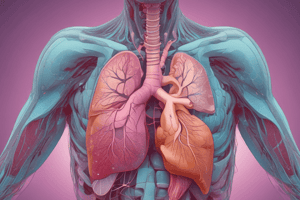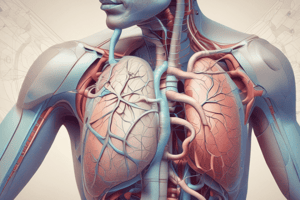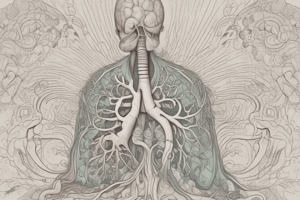Podcast
Questions and Answers
A patient with COPD is admitted to the hospital. Which percussion sound would the nurse expect to assess?
A patient with COPD is admitted to the hospital. Which percussion sound would the nurse expect to assess?
- Resonance
- Hyperresonance (correct)
- Tympany
- Dullness
During auscultation of a patient's lungs, the nurse hears high-pitched, musical sounds primarily during expiration. What adventitious sound is the nurse most likely hearing?
During auscultation of a patient's lungs, the nurse hears high-pitched, musical sounds primarily during expiration. What adventitious sound is the nurse most likely hearing?
- Ronchi
- Crackles
- Wheezes (correct)
- Stridor
A patient with a history of heart failure presents with severe shortness of breath. The nurse observes the patient leaning forward, supporting themselves with their hands on their knees. This position is known as:
A patient with a history of heart failure presents with severe shortness of breath. The nurse observes the patient leaning forward, supporting themselves with their hands on their knees. This position is known as:
- Supine position
- Tripod position (correct)
- Trendelenburg position
- Fowler's position
A nurse assesses a patient with a stage 3 pressure injury. Which characteristic would the nurse expect to find?
A nurse assesses a patient with a stage 3 pressure injury. Which characteristic would the nurse expect to find?
A nurse is assessing a patient with suspected heart failure. Upon auscultation, the nurse hears an S3 heart sound. This sound is best described as:
A nurse is assessing a patient with suspected heart failure. Upon auscultation, the nurse hears an S3 heart sound. This sound is best described as:
The nurse is using the Braden Scale to assess a patient's risk for pressure injuries. Which of the following categories are evaluated on this scale?
The nurse is using the Braden Scale to assess a patient's risk for pressure injuries. Which of the following categories are evaluated on this scale?
When assessing a patient's skin, the nurse notes a small, raised lesion with irregular borders and a pearly appearance. Which type of skin cancer is most likely?
When assessing a patient's skin, the nurse notes a small, raised lesion with irregular borders and a pearly appearance. Which type of skin cancer is most likely?
A patient presents with a complaint of a new, intensely itchy rash. On examination, the nurse observes multiple elevated, circumscribed areas of edema that are irregularly shaped and variable in size. How should the nurse document this finding?
A patient presents with a complaint of a new, intensely itchy rash. On examination, the nurse observes multiple elevated, circumscribed areas of edema that are irregularly shaped and variable in size. How should the nurse document this finding?
A nurse is assessing a patient and notices a depression in the skin that extends into the dermis. This is best described as what type of secondary skin lesion?
A nurse is assessing a patient and notices a depression in the skin that extends into the dermis. This is best described as what type of secondary skin lesion?
Which of the following is the MOST concerning finding when conducting a skin assessment using the ABCDE method?
Which of the following is the MOST concerning finding when conducting a skin assessment using the ABCDE method?
Which characteristic of aging should the nurse consider when assessing the skin of an older adult?
Which characteristic of aging should the nurse consider when assessing the skin of an older adult?
During a cardiac assessment, a nurse palpates the point of maximal impulse (PMI) in the 6th intercostal space, lateral to the midclavicular line. This finding suggests:
During a cardiac assessment, a nurse palpates the point of maximal impulse (PMI) in the 6th intercostal space, lateral to the midclavicular line. This finding suggests:
A patient is admitted with shortness of breath and pitting edema in the lower extremities. When documenting the severity of the edema, the nurse notes that the skin rebounds in 10-15 seconds after pressure is applied. Which grade of pitting edema does this indicate?
A patient is admitted with shortness of breath and pitting edema in the lower extremities. When documenting the severity of the edema, the nurse notes that the skin rebounds in 10-15 seconds after pressure is applied. Which grade of pitting edema does this indicate?
A nurse is assessing a patient's carotid artery and notices a bruit upon auscultation. What does this finding suggest?
A nurse is assessing a patient's carotid artery and notices a bruit upon auscultation. What does this finding suggest?
During an examination, the nurse notes that a patient has a bluish tinge to their tongue and oral mucosa. This finding is MOST indicative of:
During an examination, the nurse notes that a patient has a bluish tinge to their tongue and oral mucosa. This finding is MOST indicative of:
A patient is being evaluated for possible heart disease. Which of the following factors in the patient's history is considered a modifiable risk factor?
A patient is being evaluated for possible heart disease. Which of the following factors in the patient's history is considered a modifiable risk factor?
A patient's EKG strip shows normal P waves, widened QRS complexes, and inverted T waves. What does this suggest?
A patient's EKG strip shows normal P waves, widened QRS complexes, and inverted T waves. What does this suggest?
A patient is experiencing respiratory distress. Which of the following findings would warrant the MOST immediate intervention by the nurse?
A patient is experiencing respiratory distress. Which of the following findings would warrant the MOST immediate intervention by the nurse?
When assessing a patient with suspected allergic reaction, the nurse observes that the nasal mucosa appears pale, gray and swollen. This is most consistent with:
When assessing a patient with suspected allergic reaction, the nurse observes that the nasal mucosa appears pale, gray and swollen. This is most consistent with:
The nurse is assessing a patient's skin turgor. Which finding would suggest dehydration?
The nurse is assessing a patient's skin turgor. Which finding would suggest dehydration?
Flashcards
Crackles
Crackles
Short, popping sounds heard during inspiration, indicating fluid in the alveoli.
Wheezes
Wheezes
High-pitched whistling sounds during expiration, indicating narrowed airways.
Stridor
Stridor
High-pitched, harsh sound during inspiration, indicating upper airway obstruction.
Ronchi
Ronchi
Signup and view all the flashcards
Biot's respiration
Biot's respiration
Signup and view all the flashcards
Kussmaul's respiration
Kussmaul's respiration
Signup and view all the flashcards
Cheyne-Stokes respiration
Cheyne-Stokes respiration
Signup and view all the flashcards
Agonal respiration
Agonal respiration
Signup and view all the flashcards
Apnea
Apnea
Signup and view all the flashcards
Vesicular breath sounds
Vesicular breath sounds
Signup and view all the flashcards
Nail Clubbing
Nail Clubbing
Signup and view all the flashcards
Central Cyanosis
Central Cyanosis
Signup and view all the flashcards
Pitting Edema
Pitting Edema
Signup and view all the flashcards
Skin Turgor
Skin Turgor
Signup and view all the flashcards
ABCDE Skin Assessment
ABCDE Skin Assessment
Signup and view all the flashcards
Orthopnea
Orthopnea
Signup and view all the flashcards
Tripod Position
Tripod Position
Signup and view all the flashcards
JVD
JVD
Signup and view all the flashcards
Study Notes
- Adventitious sounds are extra sounds superimposed on normal breath sounds.
Crackles
- Crackles are brief, discontinuous, popping sounds.
- Fine crackles are high-pitched and occur at the end of inspiration.
- Coarse crackles are low-pitched and occur in early inspiration and sometimes expiration.
Wheezes
- Wheezes are continuous, musical, high-pitched sounds.
- They are caused by narrowed airways.
Stridor
- Stridor is a high-pitched, monophonic, inspiratory crowing sound.
- It is associated with upper airway obstruction.
Rhonchi
- Rhonchi are continuous, low-pitched snoring or rumbling sounds.
- They are caused by secretions in large airways.
Friction Rub
- A friction rub is a grating or scratching sound.
- It is caused by inflamed pleural surfaces rubbing together.
Lung Sounds Patterns
- Different lung sound patterns include Biot's respiration, Kussmaul's, Cheyne-Stokes, agonal, and apnea.
Biot's Respiration
- Biot's respiration is irregular respirations varying in depth and interrupted by intervals of apnea.
Kussmaul's
- Kussmaul's is rapid, deep, and labored breathing.
- It is often associated with metabolic acidosis.
Cheyne-Stokes
- Cheyne-Stokes is a gradual increase in depth of respirations, followed by a decrease in depth, then a period of apnea.
Agonal
- Agonal breathing is an abnormal pattern of breathing characterized by gasping, labored breathing, accompanied by strange vocalizations and myoclonus.
Apnea
- Apnea is the cessation of breathing.
Breath Sounds
- Bronchial, bronchovesicular, and vesicular sounds are normal breath sounds.
Bronchial
- Bronchial sounds are loud, high-pitched sounds heard over the trachea.
Bronchovesicular
- Bronchovesicular sounds are medium-pitched sounds heard over the major bronchi.
Vesicular
- Vesicular sounds are soft, low-pitched sounds heard over the peripheral lung fields.
Conditions
- Heart failure, pericarditis, COPD, asthma, pneumonia, right and left-sided heart failure, and ischemic and non-ischemic pain are different conditions to study.
Heart Failure
- Heart failure is a condition where the heart cannot pump enough blood to meet the body's needs.
Pericarditis
- Pericarditis is inflammation of the pericardium.
COPD
- COPD is chronic obstructive pulmonary disease.
Asthma
- Asthma is a chronic inflammatory disease of the airways.
Pneumonia
- Pneumonia is an infection of the lungs.
Right-Sided Heart Failure
- Right-sided heart failure occurs when the right ventricle has difficulty pumping blood to the lungs.
Left-Sided Heart Failure
- Left-sided heart failure occurs when the left ventricle has difficulty pumping blood to the body.
Ischemic Pain
- Ischemic pain is pain caused by reduced blood flow.
Non-Ischemic Pain
- Non-ischemic pain is pain not caused by reduced blood flow.
Nail Clubbing
- Nail clubbing is the bulbous enlargement of the ends of the fingers or toes.
- It is associated with chronic hypoxia.
Central Cyanosis
- Central cyanosis is a bluish discoloration of the skin and mucous membranes.
- It indicates hypoxemia.
Lesions
- Different shapes and configurations of lesions should be studied.
Pitting Edema
- Pitting edema is swelling in which a finger pressed into the skin leaves a visible pit.
- 1+ edema is a slight pit, 2+ is a deeper pit, 3+ is a noticeable deep pit, and 4+ is a very deep pit.
Skin Turgor
- Skin turgor is the skin's elasticity.
- It is assessed by pinching the skin and observing how quickly it returns to normal.
- Poor skin turgor can indicate dehydration.
Pressure Injuries
- Stages of pressure injuries should be studied.
Braden Scale
- The Braden Scale is a tool used to assess a patient's risk for developing pressure injuries.
Skin Cancer
- Types of skin cancer include malignant melanoma, squamous cell carcinoma, and basal cell carcinoma.
Malignant Melanoma
- Malignant melanoma is the most dangerous type of skin cancer.
Squamous Cell Carcinoma
- Squamous cell carcinoma is a type of skin cancer that develops from the squamous cells.
Basal Cell Carcinoma
- Basal cell carcinoma is the most common type of skin cancer.
Secondary Skin Lesions
- Secondary skin lesions include erosions, ulcers, scales, atrophy, and crust.
Erosions
- Erosions are loss of the superficial epidermis.
Ulcers
- Ulcers are loss of epidermis and dermis.
Scales
- Scales are flakes of skin.
Atrophy
- Atrophy is thinning of the skin.
Crust
- Crust is dried exudate.
Skin Assessment
- The danger signs of skin and the ABCDE skin assessment should be studied.
ABCDE Skin Assessment
- ABCDE stands for asymmetry, border irregularity, color variation, diameter, and evolving.
Aging Adult Skin
- Characteristics of aging adult skin should be considered.
Allergies
- Signs of allergies on the skin include rashes, nasal mucosa that appears pale, gray, and swollen, and urticaria.
Urticaria
- Urticaria is hives.
Risk Factors for Heart Disease
- Risk factors for heart disease should be studied.
Cardiac History
- Cardiac history should be studied.
Heart Sounds
- Different heart sounds, S1, S2, S3, and S4, should be studied.
S1
- S1 is the first heart sound.
S2
- S2 is the second heart sound.
S3
- S3 is the third heart sound.
S4
- S4 is the fourth heart sound.
Tripod Position
- Tripod position is a physical stance often assumed by people experiencing respiratory distress.
Respiratory Distress
- Signs of respiratory distress should be studied.
Percussion Sounds
- Percussion sounds for COPD and asthma should be studied.
EKG
- EKG waveforms PQRST should be studied.
Heart Murmur
- Assessment for heart murmur should be studied.
Vital Signs
- Vital signs should be studied.
Priority Question
- ABC (airway, breathing, circulation) priority should be studied.
Carotid and Jugular Vein
- Carotid and jugular vein (JVD) should be studied.
JVD
- JVD stands for jugular vein distention.
Studying That Suits You
Use AI to generate personalized quizzes and flashcards to suit your learning preferences.




